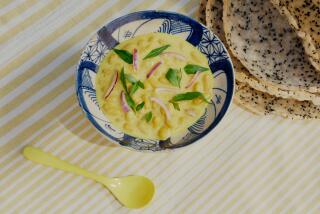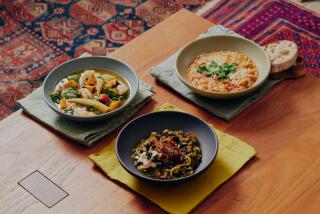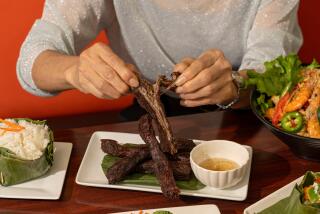The elements of stew, refined
FOR most of my life, I made stew almost without thinking. Brown some meat, toss in some vegetables and water, walk away for a couple of hours, and there it was -- dinner.
But a few years ago I ran into a recipe that completely changed the way I make (and even think about) the dish. The recipe was for Tycoon’s Goulash, in “Gundel’s Hungarian Cookbook” by Karoly Gundel. Even though it’s not a traditional stew, I came to think of the recipe as the ultimate version of the dish, one that treated each element with intelligence and care, and brought each to its fullest potential.
In the Gundel method, the broth, meat and vegetables are cooked separately and then assembled just before serving. That gives each component a distinct flavor and texture: a rich, deep broth; juicy cubes of meat with a nicely seared crust; vegetables that are crisp and tender.
Although cooking each element separately sounds cumbersome, I have adopted this method partly because of its ease of preparation.
I like to make the stock a day or two ahead so all that’s left to do is finish the sauce with tomatoes, sear the meat and cook some sort of starch to round out the dish, anything from noodles to barley to polenta.
These last bits of business all take less then 30 minutes, and, presto, you have a wonderful dish.
In fact, it is such a painless way of preparing a great meal, I began adapting it in every way I could imagine.
I developed a basic stock recipe that would work for any stew meat -- lamb or veal, as well as beef. (It also freeze beautifully, so you can have a batch easily at hand.) I found that adding a bay leaf and some fresh thyme gave the stock another dimension. I also learned that the paprika was essential -- even if I wasn’t making a goulash. It adds a rich color and body to the stock so there is no need to thicken it with flour or cornstarch.
A shopping note: When you buy soup bones, ask for ones with some meat on them for a more flavorful stock. If the bones are big, ask the butcher to crack them (or pick out smaller bones for more flavor).
Another trick: When making the basic stock I found it was best to first blanch the bones for 5 minutes, then drain and rinse them before adding them to the stockpot. This is an extra step but it will save you from constantly skimming the stock while it’s cooking.
Now onto browning the meat. To keep the meat tender, it must be seared quickly in a hot skillet, and cooked just until medium rare. (Don’t use a nonstick skillet -- the meat won’t brown as well.) Cutting the meat into small cubes and patting it dry on paper towels helps it brown quickly without stewing in the pan. Both beef tenderloin and top sirloin were delicious (the fattier top sirloin did have a little more flavor).
For an interesting version of a classic stew, I like to steam a mixture of root vegetables (rutabaga, turnips and parsnips), and serve the stew with buttered flat noodles and a garnish of cracked black pepper and a sprig of thyme.
But don’t stop there.
Let your imagination take over. Just follow the basic recipe, and vary the vegetable, starch and garnish. The possibilities are infinite, and infinitely satisfying.
*
(BEGIN TEXT OF INFOBOX)
Variations on a theme
Start with the master beef stew broth (make it ahead and freeze it if you like), then vary the finishing elements to create vastly different dishes. Here are some ideas to get you started:
Provencal
Steamed vegetables: baby yellow squash and haricots verts
Starch: white beans
Garnish: lemon slices and thyme sprigs
Tuscan
Steamed vegetables: asparagus tips and strips of red and orange bell pepper
Starch: polenta
Garnish: olives and tarragon leaves
Eastern European
Steamed vegetables: shiitake, cremini and oyster mushrooms, and red chard
Starch: barley
Garnish: fresh sage or rosemary
*
Master beef stew
Total time: 1 hour, 35 minutes
Servings: 4
Note: This can also be made with leg of lamb meat and lamb neck bones or veal tenderloin and veal knuckle bones.
3 pounds beef bones (shank or knuckle), with meat
1/4 cup oil, divided
2 cups minced onions
3 cloves garlic, crushed and coarsely chopped
3 tablespoons sweet Hungarian paprika
1 bay leaf
1 sprig thyme
Salt
3 tomatoes, peeled, seeded and chopped
1 pound beef tenderloin or top sirloin, cut into 1-inch cubes
2 cups steamed root vegetables, a mixture of rutabaga, turnip, parsnip, cut into 1/2-inch cubes
2 cups cooked flat buttered noodles
Cracked black pepper
Fresh thyme leaves, for garnish
1. Place the bones in a large saucepot. Add enough cold water to cover, and bring to a boil. Reduce the heat to medium-low and simmer 5 minutes. Drain and rinse the bones under cold water; set aside. Rinse the pot to remove any sediment.
2. Set the pot over medium-high heat and add 3 tablespoons of oil. Add the onions and garlic and cook until the onions begin to brown, 2 to 3 minutes; reduce the heat to low and continue cooking until the onions are golden, 10 minutes more. Stir occasionally to keep the onions from burning.
3. Remove the pot from the heat and stir in the paprika. Add the rinsed bones and 6 cups of water. Add the bay leaf, thyme sprig and 1 teaspoon of salt. Bring to a boil. Reduce the heat and simmer, partially covered, 1 hour. Skim the broth to remove any sediment while cooking. Remove the bones, bay leaf and thyme from the broth and skim off any fat or sediment. (The broth can be refrigerated at this point for up to three days. If the broth has been refrigerated, heat it to a simmer and proceed.)
4. Add the tomatoes and bring to a boil. Reduce the heat to a simmer and cook, partially covered, until slightly thickened, 15 minutes. Add salt to taste.
5. In a heavy skillet, brown the meat in the remaining 1 tablespoon of oil over medium-high heat until the meat is medium-rare, 2 to 3 minutes.
6. Spoon the broth into 4 large shallow bowls. Spoon the meat into the center of each bowl and surround with it steamed vegetables. Spoon the noodles on the side. Sprinkle with cracked black pepper and fresh thyme.
Each serving: 543 calories; 158 mg. sodium; 116 mg. cholesterol; 24 grams fat; 7 grams saturated fat; 48 grams carbohydrates; 35 grams protein; 7.05 grams fiber.


